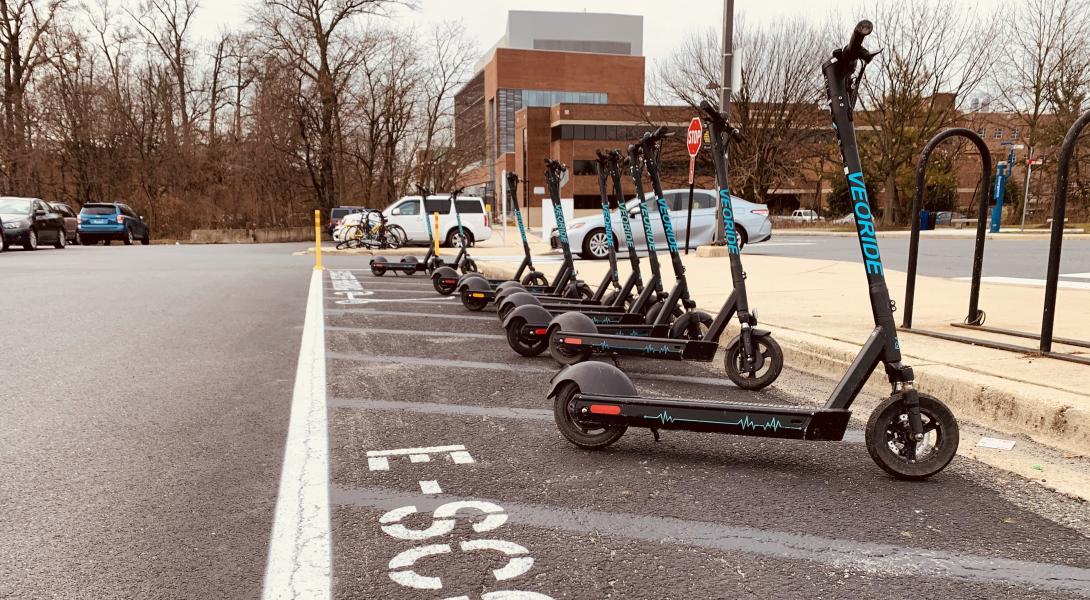
Effective August 1, 2025
Terps–This fall, we’re implementing changes related to micromobility on campus.
Transportation patterns on campus and in our region have evolved significantly in recent years. Many in the UMD community are opting to bike or scoot as part of their travel to, from and around campus. This shift from cars to more sustainable travel modes is exciting, but it also requires ongoing attention to safe and responsible integration of these modes.
Over the past year, a micromobility workgroup composed of staff from eleven departments, as well as student leaders, has developed recommendations to promote safe and responsible transportation behavior on campus.
With support from university leadership, the following changes will be implemented this fall.
Beginning in the 2025-2026 academic year, students living in residence halls, university-owned fraternity and sorority chapter houses, and South Campus Commons will be restricted from bringing privately-owned electric micromobility vehicles to campus.
These residents will not be permitted to register their electric micromobility devices with DOTS. Unregistered vehicles are subject to booting or impoundment and associated fines.
This measure is necessary to ensure the safety of resident students. The lithium-ion batteries in electric micromobility vehicles pose a fire hazard and this regulation aligns with the Fire Marshal’s existing ban on using, storing or charging vehicles inside buildings. The available charging infrastructure on campus is extremely limited and cannot support the current number of privately owned electric micromobility vehicles at UMD.
To better support current transportation needs, the university is expanding the availability and affordability of shared micromobility services like Veo and Capital Bikeshare. These services offer high-quality vehicles, without the fire risks associated with storing or charging privately-owned devices.
Both services provide special discounts for students, making electric micromobility more accessible and affordable. Additionally, UMD has partnered with Veo to introduce exciting planned improvements, including :
- A brand new fleet of vehicles with hardware and software enhancements such as AI-enabled parking coach, helmet detection, real-time tipover detection, intoxicated rider quiz, audible notifications, brake lights, underdeck lighting and improved suspension
- Curfew extension to 11 p.m. Monday-Thursday to better support end-of-class transportation
- Increased fleet size to improve vehicle availability
- Additional operational staff and resources for rebalancing and response during special events/gameday traffic
To reduce risky riding behaviors, UMPD will increase regular enforcement of moving violations.
UMPD enforces all traffic laws in accordance with the Maryland Transportation Article (MD Transp Code § 11-4 (2022)). Common violations include riding on sidewalks, failing to obey stop signs, operating vehicles with headphones covering both ears, and not adhering to obey designated lane directions. These behaviors pose significant safety risks to the campus community. Increased enforcement serves to actively reach riders and facilitate corrective behavior.
An annual $35 registration fee will be implemented for all privately-owned electric micromobility vehicles. This fee is due at the time of registration.
The $35 annual registration fee will be used to fund initiatives aimed at improving campus road safety. Additionally, registration will now be required annually (rather than every two years) to improve data accuracy.
The university will work to minimize injury by further encouraging the use of protective gear.
Studies show that wearing a properly fitting helmet can significantly reduce the risk of severe injury. To help Terps protect their “shell,” DOTS will distribute free helmets and lights to the first 300 people who register their electric micromobility device.
Over the past several years, UMD has been actively engaged in strategies to improve campus road safety. These efforts include short- and long-term transportation planning, safety education and outreach, device registration, low campus speed limit of 15 m.p.h., infrastructure improvements and enforcement of traffic laws. The new initiatives will help to create a safer and more accessible campus for all.
NOTE: Important information for Courtyards apartments residents. While current UMD regulations allow for registration of electric micromobility devices with DOTS, Courtyards management is no longer permitting residents to register personal electric micromobility devices through the Courtyards housing office. As noted in current Courtyards policy, residents are prohibited from parking or storing personal electric micromobility devices at any indoor or outdoor location within the Courtyards apartment community. Residents can continue to access Veo e-scooters/e-bikes at Courtyards. For questions, please contact Courtyards management at thecourtyards@cocm.com.
